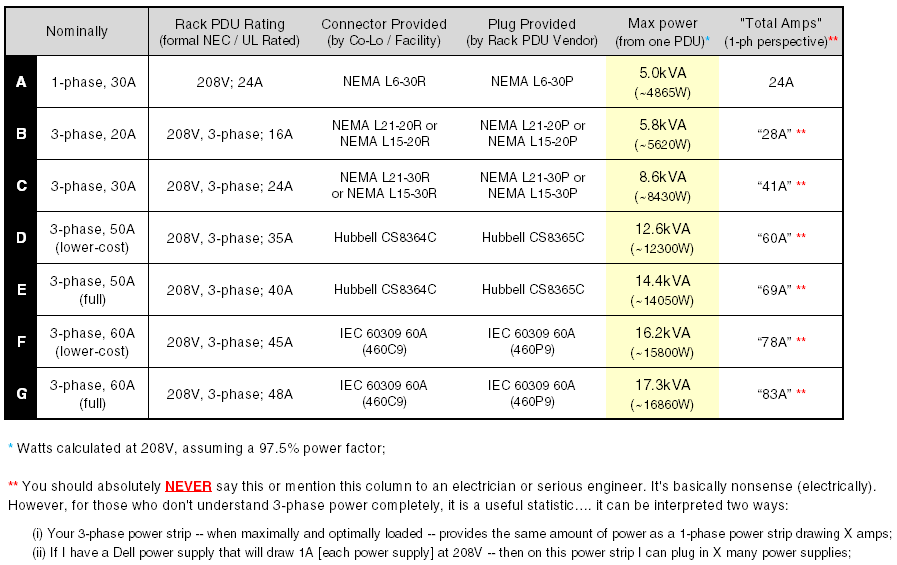部落格
主頁 » 部落格 » 3-phase, 208V Power Strips (Rack PDUs) Demystified, Part II : Understanding Capacity
3-phase, 208V Power Strips (Rack PDUs) Demystified, Part II : Understanding Capacity
Posted on April 9, 2013 by Gento
Despite the growing ubiquity of 3-phase power distribution (at 208V) in North American data centers, data center operators are still not sufficiently fluent with the real-world capacity implications of 3-phase power in their cabinets.
The principal reason is because—at 208V—the math required to understand 3-phase power distribution at the cabinet is completely counter-intuitive.
THE TWO MOST COMMON QUESTIONS I GET are some form of the following:
- On a single-phase power strip, I was able to power 10 servers. So how many will I be able to plug into this three-phase power strip? 30?
- I have a three-phase, 30A power strip. Does that mean I can have up to 30amps on each of the three phases of the power strip? That is, 90A total?
Whatever you think is reasonable in your head is, in fact, not actually the way it works. So the answer to both of the above questions is, “no”.
In a previous post, I attempted to explain at a lower-level the reasons why this is true—including a link to a very useful Excel spreadsheet to help you calculate 3-phase rack PDU loading and capacity planning..
But I realize that most people are like me (lazy). You don’t need to know the electrical rationale for the counter-intuitive math, you just need to know the answers! So in this post you will find just the main information you need to do simple capacity planning (without explaining the reasons why). I guess I really should have posted this first. Whoops!
THE SHORT VERSION: 2 Primary Tips
1. If you don’t totally, 100% understand 3-phase power distribution, it is best if you do NOT think or speak in terms of amps. In all likelihood, you will say something incorrect that confuses your electrician.
Instead, think about how many watts your equipment consumes, and how many watts your 3-phase power strip can provide. Watts are universally comparable, regardless of the supplied electrical configuration available at your rack: both your power strip manufacturer and your IT equipment vendor will tell you how many watts can be supplied. No matter what voltage you use; the rated current (amps); or whether you have 1-phase power or 3-phase power; etc… you can always compare watts.
If you absolutely must think using amps (i.e., “My Dell salesperson says this server will draw a maximum of 1.4A; and that’s all he will tell me.”), then I strongly suggest you: (a) download and use our 3-phase calculator here; and (b) consult the right-most column of the following cheat-sheet.
2. Print out this chart, pin it on your bulletin board ... and trust no other document on earth. (Click to view as high-resolution PDF).
SOME OBSERVATIONS
- This chart (and this blog post) applies ONLY to 208V, 3-phase power. If your facility utilizes 400V, 3-phase; or 415V, 3-phase power [i.e. most of EU, many other countries, and many of Raritan’s largest customers in North America]—then this information does not apply to you!!!
- Compare A and C in the chart above. Note that going from a single-phase (30A) power strip to a three-phase (30a) power strip does NOT get you 3x more power. That is a common misconception. Instead, you get 1.732x more power [the square root of 3]. Again, you will have to consult my previous post for an explanation why.
- Most rack PDU Manufacturers offer two versions of “50A, 3-phase” power strips—Options D and E in the chart above. In both cases, your co-location facility (or data center facility) provides a 50A, 3-phase input. But one power strip costs much less than the other. That is to say, moving from D to E increases the power strip’s costs materially, while offering only ~14% more power. That is why Rack PDU vendors often recommend Option D. EXCEPTION TO THE RULE: Most co-location customers [i.e., not owner/operator].
- Similarly, many rack PDU Manufacturers offer two versions of “60A, 3-phase” power strips—Options F and G in the chart above. This is less common, but does occur on occasion.
THIS INFORMATION IS VENDOR NON-SPECIFIC
Please note that all the information in this post is not specific to Raritan power strips—but is vendor-agnostic… it’s just math. (Of course, if you do find this information beneficial, I sure would appreciate your considering Raritan as a potential provider for critical power distribution in your next build.)
Learn the most innovative features of rack power distribution units.
Other Blog Posts
- 從資料中心失效對企業帶來的骨牌效應──探討感測器的重要性
- Posted on November 5, 2023
- 更高規格的電源要求加速AI市場成長與Raritan PDU的採用
- Posted on October 11, 2023
- 資料中心服務中斷次數減少,但停機的代價仍舊可觀
- Posted on September 20, 2023
- 意見調查:資料中心面臨能源使用與人力短缺困境
- Posted on September 20, 2023
- Raritan安全切換器:相容於Secure NIAP 4.0的桌上型KVM
- Posted on September 20, 2023
訂閱
近期活動
- New Zealand Cloud & Datacenter Convention 2022
- 3 November 2022, 9am – 4pm • Grand Millennium Hotel, Auckland, New Zealand
- Data Centre World Singapore
- 12th – 13th Oct 2022
- Korea Cloud & Datacenter Convention 2022
- 6th Oct 2022
- Philippines Cloud & Datacenter Convention 2022
- 4th Aug 2022
- JANOG50 Meeting Hokkaido
- 3th – 15th July 2022
Raritan最新新聞
- Legrand 使用兩大創新智慧型機架 PDU 重新活化資料中心產業
- Posted on May 1, 2023
- Exclusive interview丨How does Huizhou upgrade its manufacturing industry?
- Posted on December 2, 2021
- Raritan 發表 MasterConsole® 數位雙電腦切換器
- Posted on February 18, 2021
- Legrand Data, Power and Control Division Announced as Finalist in Six Categories at DCS Awards 2020
- Posted on November 9, 2020
- Raritan 新款智慧機櫃控制器 (SRC) 可智慧管理資料中心與關鍵任務設施的環境與安全性資訊
- Posted on November 9, 2020

